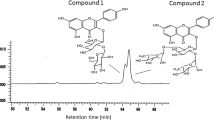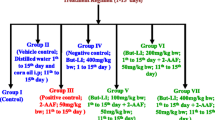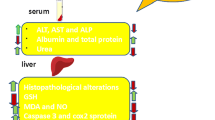Abstract
This study aims to investigate the antioxidant and hepatoprotective effects of kaempferol 3-O-β-d- (2,6-di-O-α-l-rhamnopyranosyl)galactopyronoside (KG) isolated from unripe soybean leaves. Carbon tetrachloride (CCl4)-induced hepatotoxic ddY mice were used in the study. The mice were divided into three groups, namely the control group, the CCl4 group (CCl4, CCl4 injected), and the KG group (KG, CCl4 injected with KG administration). Hepatic injury markers of serum and liver were analyzed. The results show that serum ALT, AST activities, hepatic glutathione, superoxide dismutase, catalase, and glutathione peroxidase activities were normalized in mice pretreated with KG. Furthermore, the liver thiobarbituric acid reactive substances levels were found to be improved by pretreatment with KG, indicating that KG is available to alleviate liver injury, this may be due to its antioxidant properties. This study suggests that unripe soy leaves could be used as functional food materials.
Similar content being viewed by others
Avoid common mistakes on your manuscript.
Introduction
Liver injury, which is generally considered to be related to oxidative stress cases, occurs worldwide. It usually begins with steatosis to chronic hepatitis, fibrosis, and cirrhosis and finally develops into hepatocellular carcinoma [1]. Carbon tetrachloride (CCl4) has been used as a hepatotoxin for many years; it can induce liver injury in various experimental models for studying the mechanisms of hepatotoxicity [2].
Kaempferol is one of the flavonoids commonly found in some vegetable, fruits, and traditional medicine. In nature, almost all dietary flavonoids exist in their glycoside forms [3]. Kaempferol usually bonds with glucose, rhamnose, galactose, and rutinose to exist in its glycoside form [4]. Some kaempferol glycosides are easily found in nature, e.g. kaempfero-3-O-glucuside, because their biosynthesis progresses in simple ways; i.e. it only requires some type of enzymes that are widespread in nature. However, some other kaempferol glycosides are more restricted because glycosides can only be synthesized by certain plant species that can provide certain enzymes along with genetic information [3].
In recent years, numerous kaempferol glycosides have been identified and the bioactivities of some of these glycosides have been studied [4]. In the authors’ previous studies, several kaempferol glycosides were separated and identified in unripe soybean leaves (Glycine max. L. Merr. “Jindai”); furthermore, the antidiabetic and antiobesity effects of the kaempferol glycoside fraction were proven in model mice [5,6,7]. However, to our knowledge, most of the related literature has focused on the mixture of kaempferol glycosides or the kaempferol glycoside fraction and only a few studies have investigated the bioactivities of purified compounds, especially that of kaempferol 3-O-galactoside in vivo.
In this study, kaempferol 3-O-β-d- (2,6-di-O-α-l-rhamnopyranosyl)galactopyronoside (KG) was purified from unripe soybean leaves (Glycine max. L. Merr. “Jindai”) and the properties of the antioxidant and its protective effects on liver damage caused by CCl4 in mice were studied.
Materials and methods
Materials
Jindai Soybean (Glycine max. L. Merr. “Jindai”) leaves were collected in September 2014 from the Mogami area of Yamagata Prefecture, Japan. The leaves were administered according to the methods described in the authors’ previous study [5]; to obtain the kaempferol glycosiede-rich fraction, a 20% MeOH solution was applied to a silica gel column (prepared with n-hexane) and developed with n-hexane/EtOAc and EtOAc/MeOH systems successively. Development with the EtOA/MeOH system was performed using EtOAc:MeOH ratios of 9:1, 8:2, 7:3, 6:4, and 5:5; (v/v) successively. A kaempferol glycoside fraction comprising four compounds was obtained. The fraction was further purified using polyamide column chromatography (Developing solvent: EtOAc:CHCl3:88%HCOOH:H2O = 19:1:1:1, v/v). The fraction containing KG as the major component was subjected to Sephadex LH20 column chromatography (Eluent, 50% EtOH); KG was finally purified using preparative high-performance liquid chromatography (HPLC; a solvent system comprising solvent A:5% acetonitrile with 1% acetic acid and B:40% acetonitrile, the linear gradient of 0–100% of solvent B in solvent A) using a Develosil C-30, UG-5 column (25 mm × 250 mm, Aichi, Nagoya, Japan). The obtained KG (35 mg, purity = ~60%) was used in an animal experiment. The HPLC chromatogram and the chemical structure of the obtained KG are shown in Fig. 1.
Animals
The ddY mouse model, a spontaneous animal model that resembles the human situation on some diseases, has been widely used in various studies. Eight-week-old male ddY mice (Shizuoka Laboratory Animal Center (SLC), Shizuoka, Japan) were acclimated for 5 days in an environment with a temperature of 22 ± 2 °C, humidity of 40–60%, and lighting for 12 h in the dark cycle. The mice were divided into three groups after 3 days of acclimation, namely the control group (CON group, seven mice), the CCl4-induced-liver-injury group (CCl4 group, seven mice), and the KG group (CCl4 + KG group, seven mice).
After fasting for 8 h, the mice were administered one of the following solutions: 0.2 mL of a 0.5 g/dL sodium carboxymethyl cellulose (CMC) solution per mouse for the CON and CCl4 groups and 0.2 mL of a 0.5 g/dL CMC solution containing 4.5 mg KG per mouse for the KG group. The mice in the CON group were injected intraperitoneally with 30 μL olive oil 30 min after the oral administration of the 0.5 g/dL CMC solution. The CCl4-group mice were injected intraperitoneally with a mixture of 30 μL olive oil and 30 μL CCl4 30 min after the oral administration of the CMC solution. The KG group mice were injected with a mixture of 30 μL olive oil and 30 μL CCl4 30 min after the oral administration of the CMC solution containing KG sample. After 22 h, all mice were anesthetized with Nembutal (Dainippon Pharmaceutical Co., Osaka, Japan), followed by the collection of blood from the heart. Then, the liver was detached; it was stored at a temperature of −80 °C until analysis. The blood was centrifuged at 3000×g for 15 min at 15 °C to obtain serum, which was then used for measuring the ALT and AST activities.
Measurement of the ALT and AST activities
The ALT and AST activities in the serum were measured enzymatically. One unit of the enzyme activity is defined as the amount of enzyme required to transform 1 µmol of substrate per min per liter of serum (µmol/min/L of serum at 25 °C).
Measurement of the antioxidant enzyme activities
Liver samples (0.5 g) were homogenized with 2.5 mL of potassium phosphate buffer [0.1 M, pH = 7.4, containing 1 mM of EDTA and 1 mL of KCl (2.3 g/dL)], followed by centrifugation at 10,000×g at 4 °C for 20 min. The SOD, CAT, and GSH-Px activities were measured using the obtained supernatant. The SOD activity was measured using a xanthine/xanthine oxidase system [8], and the CAT activity was determined using the method of Chance and Meahly [9]. To determine the GSH-Px activity, the decrease in the NADPH level due to the reaction was measured; one unit of GSH-Px activity is defined as the amount of enzyme required to oxidize 1 µmol of NADPH per min per mg of protein [10,11,12].
Measurement of GSH and GSSG
The frozen liver sample (0.5 g) was homogenized with 5 mL 0.4-N perchloric acid (containing 2.0-mM EDTA). Centrifugation of the homogenate at 10,000×g for 5 min was performed at 5 °C to obtain the supernatant. The supernatant was filtered using a 0.20-µm filter. GSH and GSSG in the filtrate were determined via ion-pair reverse-phase HPLC using a coulometric detector, as reported by Harvey et al. [13].
Measurement of TBARS
The liver sample (0.5 g) was homogenized in a Teflon homogenizer on ice with 3 mL of the potassium phosphate buffer (0.1 M, pH = 7.4, containing 1 mM of EDTA and 1.2 mL of 2.3 g/dL KCl); moreover, the TBARS level was measured [14].
The composition of the basal diet is casein (20%), α-corn (starch:sucrose = 2:1, 65.5%), cellulose (5%), mineral mixture (3.5%), vitamin mixture (1%), and corn oil (5%).
Our study was conducted in accordance with the Guide for the Care and Use of Laboratory Animals of Yamagata University and was approved by the Committee on the Ethics of Animal Experiments of Yamagata University.
Statistical analysis
The data were presented as the mean ± SEM. Significant differences among the groups were determined using one-way analysis of variance. The homogeneity of the variance between the treatments was verified using Bartlett’s test. Tukey’s test was used to analyze the values with a significant difference of p < 0.05.
Results and discussion
Natural flavonoids, including aglycones and their glycosides are abundant in food materials; therefore, they have received significant attention from researchers because of their biological benefits [3]. Since the 90s, the absorption properties and metabolism of dietary flavonoids have been widely investigated. Generally, flavonoid glycosides are considered to be hydrolyzed to their aglycone forms and absorbed as their aglycone forms [15]. The former are composed of smaller molecules and are considered to be more hydrophobic; in addition, they can be easily absorbed by epithelial cells through passive diffusion. However, it is still unknown which form is actually absorbed, i.e. aglycones, glycosides, or both of them. It has been reported that both quercetin 3-O-glucoside and quercetin 4′-O-glucoside are absorbed rapidly by the human body despite their different sugar moiety positions [3]. Another study illustrated that quercetin 3-O-glucoside has a very good curative effect on cancer and shows a superior pharmacological effect compared with its aglycone quercetin [16]. These factors indicate the necessity of studying the bioactivities of flavonoid glycosides.
In the present study, we investigated the hepatoprotective effects of a kaempferol galactoside purified from soybean leaves on CCl4-induced liver injury in mice. Our previous studies have shown the antiobesity and antidiabetic effects of the kaempferol glycoside fraction in model mice; it is considered that these effects are partly associated with the antioxidant effects of the kaempferol glycoside fraction [6, 7, 17]. Some other studies have also demonstrated the antioxidant activity of kaempferol glycosides in vitro [18, 19]. However, to the best of our knowledge, this is the first study on the hepatoprotective effects of KG in vivo.
CCl4 administration induced elevated levels of the serum enzymes, e.g. ALT and AST, and the ability to decrease the enzyme levels was considered to be the hepatoprotective ability [20]. It is considered that the difference between the enzyme levels in the CCl4 and CON groups is an indication of hepatic tissue damage. The most common abnormality in laboratory parameters is elevated serum levels in transaminases (ALT and AST). In the present study, the serum ALT and AST activities 22 h after the administration of CCl4 at a dose rate of 30 μL per mouse are shown in Fig. 2, which shows that CCl4 administration caused a significant elevation in the levels of ALT and AST in the CCl4 group; this indicates the occurrence of hepatocyte injury in the CCl4-injceted mice. KG administration at the dose rate of 4.9 mg per mouse significantly reduced the activities of ALT and AST when compared with CCl4 administration. These results indicate that kaempferol galactosides with rhamnose moieties possess potent protective activity for causing liver injury. This assertion is based on the fact that kaempferol 3-O-glucoside or kaempferol 3-O-rutinoside are effective in preventing liver injury [21].
In the body of humans and animals, the defense systems possess a host of antioxidant systems. e.g. a nonenzymatic GSH system, and a series of antioxidant enzymes such as SOD, GSH-Px, and CAT, which scavenge overproduced reactive oxygen species (ROS) and other free radicals to protect cells from oxidative damage [22]. GSH is the major nonprotein thiol in animal cells; moreover, it is essential to regulate the cellular functions that can reduce H2O2, hydroperoxide (ROOH), and xenobiotic toxicity [23]. In the present study, it was observed that the liver GSH, SOD, GSH-Px, and CAT levels in the CCl4-group mice were significantly lower than those in the CON-group mice (Figs. 3 and 4), representing the oxidative status of hepatic cells. The significantly increase in the liver GSH, SOD, GSH-Px, and CAT activities in the KG group mice indicates that the CCl4-induced oxidative status was suppressed by KG administration. The antioxidant effects of kaempferol glycosides were also demonstrated in a previous study [24].
Lipid peroxidation is one of the major outcomes of a free-radical-mediated injury that directly damages membranes and generates a number of secondary products in vivo to progress oxidation [25]. The measurement of TBARS is a well-established method for screening and monitoring lipid peroxidation. In the present study, KG significantly suppressed the elevation of liver TBARS (Fig. 5). This positive response was mainly attributed to the radical scavenging activity of KG, which might be incorporated in their aglycone form in the digestive tracts, against the reactive oxygen species evoked in vivo. This study indicates that the KG shows hepatoprotective activities against CCl4-induced acute liver injury, presumably in the same magnitude as its aglycone form, kaempferol.
References
Harish R, Shivanandappa T. Hepatoprotective potential of Decalepis hamiltonii (Wight and Arn) against carbon tetrachloride-induced hepatic damage in rats. J. Pharm. Bioallied Sci. 2: 341–345 (2010)
Hardin BL Jr. Carbon tetrachloride poisoning; a review. Ind. Med. Surg. 23: 93–105 (1954)
Xiao J, Chen T, Cao H. Flavonoid glycosylation and biological benefits. Biotechnol. Adv. 2014. doi:10.1016/j.biotechadv.2014.05.004.
Calderón-Montaño JM, Burgos-Morón E, Pérez-Guerrero C, López-Lázaro M. A review on the dietary flavonoid kaempferol. Mini Rev. Med. Chem. 11: 298–344 (2011)
Zang Y, Sato H, Igarashi K. Anti-Diabetic Effects of a Kaempferol Glycoside-Rich Fraction from Unripe Soybean (Edamame, Glycine max L. Merrill. ‘Jindai’) Leaves on KK-A(y) Mice. Biosci. Biotechnol. Biochem. 75: 1677–1684 (2011)
Zang Y, Zhang L, Igarashi K, Yu C. The anti-obesity and anti-diabetic effects of kaempferol glycosides from unripe soybean leaves in high-fat-diet mice. Food & Function. 2015. doi:10.1039/c4fo00844h.
Zang Y, Igarashi K, Yu C. Anti-obese and anti-diabetic effects of a mixture of daidzin and glycitin on C57BL/6 J mice fed with a high-fat diet. Biosci. Biotechnol. Biochem. 79: 117–123 (2015)
Imanari T, Hayakawa M, Miyazaki M. Improved assay method for superoxide dismutase. Igaku no Ayumi. 101: 496–497 (1977)
Chance B, Meahly AC. Methods in enzymology. New York: Academic Press. 2: 764–775 (1955)
Paglia DE, Valentine WN. Studies on the quantitative and qualitative characterization of erythrocyte glutathione peroxidase. J. Lab. Clin. Med. 70:158–169 (1967)
Whanger PD, Weswig PH, Schmitz JA, Oldfield JE. Effects of selenium and vitamin E on blood selenium levels, tissue glutathione peroxidase activities and white muscle disease in sheep fed purified or hay diets. J. Nutr. 107: 1298–307 (1977)
Lowry OH, Rosebrough NJ, Farr AL, Randall RJ. Protein measurement with the Folin phenol reagent. J. Biol. Chem. 193: 265–275 (1951)
Harvey PR, llson RG, Strasberg SM. The simultaneous determination of oxidized and reduced glutathiones in liver tissue by ion pairing reverse phase high performance liquid chromatography with a coulometric electrochemical detector. Clin. Chim. Acta. 180: 203–12 (1989)
Mihara M, Uchiyama M. Determination of malonaldehyde precursor in tissues by thiobarbituric acid test. Anal. Biochem. 86: 271–8 (1978)
Walle T, Browning AM, Steed LL, Reed SG, Walle UK. Flavonoid glucosides are hydrolyzed and thus activated in the oral cavity in humans. J. Nutr. 135: 48–52 (2005)
Park SH, Kim HJ, Yim SH, Kim AR, Tyagi N, Shen H. Delineation of the role of glycosylation in the cytotoxic properties of quercetin using novel assays in living vertebrates. J. Nat. Prod. 77: 2389–2396 (2014)
Li H, Ji HS, Kang JH, Shin DH, Park HY, Choi MS. Soy Leaf Extract Containing Kaempferol Glycosides and Pheophorbides Improves Glucose Homeostasis by Enhancing Pancreatic beta-Cell Function and Suppressing Hepatic Lipid Accumulation in db/db Mice. J. Agric. Food Chem. 63: 7198–21 (2015)
Zhu XY, Lin HM, Chen X, Xie J, Wang P. Mechanochemical-assisted extraction and antioxidant activities of kaempferol glycosides from Camellia oleifera Abel. meal. J. Agric. Food Chem. 59: 3986–93 (2011)
Jung HA, Woo JJ, Jung MJ, Hwang GS, Choi JS. Kaempferol glycosides with antioxidant activity from Brassica juncea. Arch. Pharm. Res. 32: 1379–84 (2009)
Singab AN, Ayoub NA, Ali EN, Mostafa NM. Antioxidant and hepatoprotective activities of Egyptian moraceous plants against carbon tetrachloride-induced oxidative stress and liver damage in rats. Pharm. Biol. 48: 1255–64 (2010)
Kubomura K, Kurakane J, Molyneux M, Omori M, Igarashi K. Identification of the major polyphenols in boysenberry leaves and their suppressive effect on carbon tetrachloride-induced liver injury in mice. Food Sci. Technol. Res. 12:.31–7 (2006).
Valko M, Rhodes CJ, Moncol J, Izakovic M, Mazur M. Free radicals, metals and antioxidants in oxidative stress-induced cancer. Chem. Biol. Interact. 160: 1–40 (2006)
Naik SR, Thakare VN, Patil SR. Protective effect of curcumin on experimentally induced inflammation, hepatotoxicity and cardiotoxicity in rats: evidence of its antioxidant property. Exp. Toxicol. Pathol. 63: 419–431 (2011)
Wang Y, Tang C, Zhang H. Hepatoprotective effects of kaempferol 3-O-rutinoside and kaempferol 3-O-glucoside from Carthamun tinctorius L. on CCl4-induced oxidative liver injury in mice. J. Food & Drug Analysis. 23: 310–317 (2015)
Chen X, Ying X, Zhang W, Chen Y, Shi C, Hou Y. The hepatoprotective effect of fraxetin on carbon tetrachloride induced hepatic fibrosis by antioxidative activities in rats. Int. Immunopharmacol. 17: 543–547 (2013)
Acknowledgements
Financial support for this research was provided by Science and Technology Innovation Team Construction Plan in Colleges and Universities of Heilongjiang Province (2014TD006), National Natural Science Foundation (81673170), and Initial Founding of Scientific Research of Heilongjiang Bayi Agricultural University (XYB2013-24).
Author information
Authors and Affiliations
Corresponding author
Ethics declarations
Conflict of interest
The authors declare no conflict of interest.
Rights and permissions
About this article
Cite this article
Zang, Y., Zhang, D., Yu, C. et al. Antioxidant and hepatoprotective activity of kaempferol 3-O-β-d- (2,6-di-O-α-l-rhamnopyranosyl)galactopyronoside against carbon tetrachloride-induced liver injury in mice. Food Sci Biotechnol 26, 1071–1076 (2017). https://doi.org/10.1007/s10068-017-0170-7
Received:
Revised:
Accepted:
Published:
Issue Date:
DOI: https://doi.org/10.1007/s10068-017-0170-7









